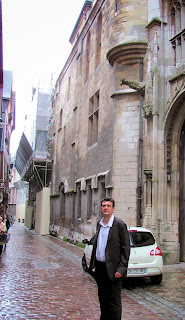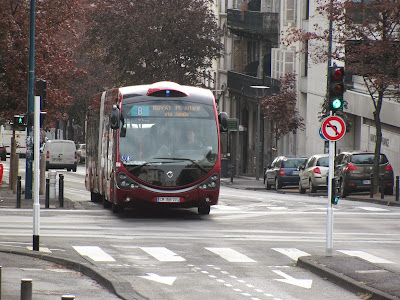Recent Developments in Public Transportation
Topic 1, Part 3
Bus Rapid Transit through Light Rail:
Pavement-Guided Buses
More complex systems for guiding buses (compared to curb-guided systems) make use of markers buried in the pavement or placed on the pavement's surface. These run on have rubber tires, and can be steered either manually or by computer-based hardware/software combinations.Two systems are out there:
- "Phileas": uses magnetic beacons embedded in pavement. It was developed by the consortium Samenwerkingsverband Regio Eindhoven (SRE), Netherlands, along with some other companies for the Cooperation Foundation Eindhoven Region - most prominently Advanced Public Transit Systems (APTS), VDL Bus and Coach, and Bombardier. A Dutch company, Frog Navigation Systems, developed the technology known as FROG that uses small magnets embedded in the road surface
- "Optiguide": uses painted marks on roadway. Siemens (multinational), developed and owns the guidance system. To date, buses guided by Optiguide have been built by Iveco Irisbus (Italian), but probably any company willing to work with Siemens could design buses to use the system.
Phileas
 |
| Phileas vehicle (largest configuration) (Photo: VDL Bus and Coach) |
I haven't had a chance to visit a Phileas system, which so far has only been deployed in Eindhoven, Netherlands. A few other cities are in various stages of developing Phileas systems, but the overwhelming evidence seems to be that Phileas is "not ready for prime time".
For starters, there are been serious problems with the motive power. Several energy sources are available, including diesel, compressed natural gas, and straight electric from twin trolley wires. The power systems using fossil fuels are all hybrid (both series and parallel have been tried) but have experienced difficulties with the hybrid transmission systems.
But most serious of all, there have been major problems with the FROG ("Free Range on Grid") magnetic guidance system. FROG automatic guided vehicles have been demonstrated to be effective in controlled environments, hauling cargo in warehouses and manufacturing facilities, and providing shuttle service at airports. But when let loose on the streets of Eindhoven, they proved both reckless and easy to confuse. In automatic mode, they attempted to accelerate the buses to the maximum allowed speed, without regard to pedestrians. They would barrel along and, for various reasons, would stray from their appointed path. They were programmed to apply full braking power immediately upon straying more than 25 cm (about 10 inches) from their path. When this happened - and apparently it did fairly frequently - they would make an "emergency" stop, sending passengers flying. Traffic signals turned out to be another problem: perhaps because of the detector loops embedded in the pavement, the FROG system would become disoriented, signal a fault, and prevent the bus from moving forward.
These problems have proven difficult to overcome. As of last report (September, 2008), Eindhoven transit has discontinued use of the FROG system except for docking, and passengers have been calling it "Phileasco" (Phileas+fiasco). Other cities attracted to the potential of the Phileas system have been unable to procure buses, due to the constant need for the manufacturer to recall their vehicles for modification. As a result, Phileas cannot be considered a realistic option at this time.
Optiguide
 | |
| Olivier Rateuivillie (Photo: L. Krieg) |
The Optiguide system uses a simple pattern of white lines painted on the pavement. In the bus, a sophisticated hardware/software combination detects the guidelines through a video camera and signals the driver when it is about to take over the steering. Unlike FROG, Optiguide does not attempt to control starting, stopping, or speed - these all remain the driver's responsibility. And when necessary, the driver can override the automatic steering.
 |
| Rouen BRT with Optiguide Bus-only lanes (red pavement with guide marks) Bulge on bus-top houses guidance video equipment (Photo: L. Krieg) |
In Rouen, the buses use automatic guidance only when they are approaching a station on the main BRT route. Rouen built a BRT corridor through the most congested parts of the city, and this corridor is shared by three routes which fan out into different suburbs. Once past the central corridor, the buses run in lanes shared with general traffic, and are operated like standard articulated buses.
 |
| Map of Rouen BRT Routes (Map: CREA; English overlays: L. Krieg) |
Here's some video I shot while I was there:
Olivier gave me a presentation - apparently many other cities have sent delegations to observe their Optiguide. This presentation gives an overview of the history and finances, as well as the BRT infrastructure and operation. I was interested to note that operating funds amounting to €372,000 was spent in 2010 for "Guidage véhicule" (vehicle guidance), but did not ask for an explanation. I would have expected the vehicle guidance system to be a capital expense, rather than an operating expense amounting to about 23% of the infrastructure maintenance cost. The capital cost of the Optiguide system is rolled into the vehicle cost, and its actual cost is not readily available.
 |
| Optiguide in Clermont-Ferrand (Photo: L. Krieg) |
Pros and Cons
Due to the problems with Phileas, I'll list here only the Pros and Cons I see for the Optiguide system:| Pro | Con |
|---|---|
| Flexible: to guide or not to guide, according to needs | Pavement must be kept clear |
| Based on available bus models (potentially multiple vendors) | Only one guidance system vendor (Siemens) |
| Uses well-defined BRT systems | Very few installations |
| More expensive than curb-guidance systems |
To learn more:
- FROG Guidance Systems and Phileas Buses
- FROG AGV Systems home page
- Lane Assist Systems for Bus Rapid Transit, Volume I: Technology Assessment. (PDF) Steven E. Shladover, et al., California PATH Research Report UCB-ITS-PRR-2007-21 (2007)
- Quirepace Lamson, "FROG - Automated Guided Vehicles"
- City Transport "New Era Hi-tech Buses" Phileas section
- Optiguide System
- Rouen BRT presentation using North American terminology and English measure, enhanced with video
- Rouen BRT presentation in original English version (British terminology, metric measures)
- City Transport "New Era Hi-tech Buses" optical guidance section
- Previous posts in this series, "Bus Rapid Transit through Light Rail":



















